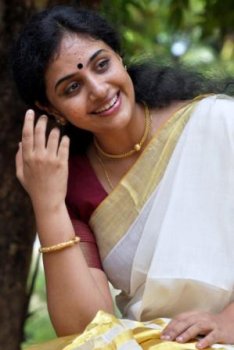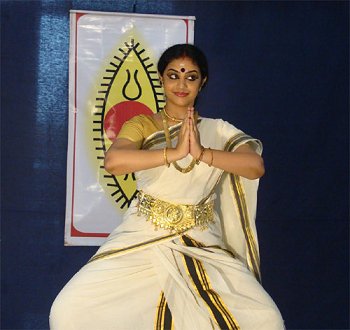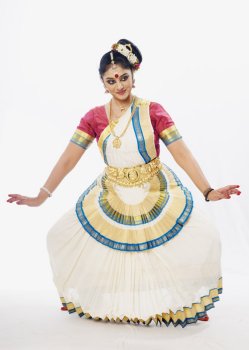Narthaki

News

Info

Featured


|
 |
I have a lot more to give: Methil Devika - Lalitha Venkat, Chennai e-mail: lalvenkat@yahoo.com September 6, 2011 Methil Devika received her initial tutelage in dance at the age of four from Melattur S Natarajan, a disciple of veterans Balu Bhagavathar and KP Kittappa Pillai. In Kuchipudi, she did her formative as well as advanced training under Satyapriya Ramana in Chennai. Devika was also trained by Guru Vempati Ravi at the Kuchipudi Dance Academy of Guru Vempati Chinna Satyam. Devika took her Masters degree in Kuchipudi at Rabindra Bharati University, Kolkata with a first rank and gold medal. Devika is trained in Mohiniattam under Girija Chandran, student of Kalamandalam Kalyanikuttyamma. She also trained for a brief period under Kalamandalam Leelamma mastering the technicalities of the much acclaimed Kalamandalam sampradaya of Mohiniattam. She is associated with scholars like Dr. VS Sharma, Kavalam Narayana Panikker and Nelliyode Vasudevan Nampoothiri for their guidance in many facets of choreography. Devika joined Kerala Kalamandalam Deemed University in 2009. She has developed modules to enable the mentally challenged to express non-verbally. Devika has choreographed the song 'Malar manchariyil vandineppol' in VK Prakash's film 'Karmayogi.' She has a master's degree in business administration, with specialization in marketing. She is presently working for a doctorate at the Bharathidasan University.  Can you tell us about your teaching experience at Kerala Kalamandalam? I have been fortunate to teach the MA/MPhil students in the department of Mohiniattam at Kerala Kalamandalam. I would say the graduate and under-graduate programs in Mohiniattam, Kathakali, Koodiyattam, Thullal and percussion are par excellence with the students benefiting from both a rigid gurukula system as well as a UGC approved academic system. Personally it has been creatively beneficial to me because of the wonderful library and the culturally vibrant ambience with the Bharatapuzha flowing next to my campus (the old campus) sometimes serenely and at times so violently. The river kind of typifies the artistic mentality at the campus. The location of Kerala Kalamandalam is on the Palakkad-Thrissur belt which has always been the seat of art. I enjoy teaching and learning at the same time. I have learnt a lot from the negatives of a politically driven campus as also from the positives of my own creative elevations in such breathtaking ambience. I love the magnificence of the koothambalam and the wonderful kalari-s. But I do not like the general notion there that Mohiniattam begins and ends with Kerala Kalamandalam. I also know that I have a lot more to give than what I am giving the students now. Unfortunately they do not want it. As a judge on a TV dance show, how is the standard of dance on the show? What have you learnt from the experience - apart from patience! I have earlier been a judge on a dance show that had all categories of dancing. It was certainly not great but it was not that bad either. I had the liberty to dictate the dos and don'ts of stage etiquette. Recently I was judge on a reality show on Mohiniattam which I would say was really good. One thing is for sure. It is a short-cut to fame. And the participants are deprived of the beauty of a long term learning process. Fortunately the winners invariably have been those who have been well-trained. They bask in the glory of their success for a year or two with performances almost every day. But once it ends, the passionate are sure to return to the rigidity of a lifelong learning process. TV is a powerful medium with people recognizing me as a dancer even in buses and trains. Because of the reality show, I was invited to dance for star-studded stage shows which I never did. Not that it is wrong. I would never be comfortable. Surprisingly, no one wanted a kutcheri. The kutcheris I do only come from my regular connoisseur-organizers and festival committees.  You lecture and perform under the auspices of Spic Macay. Can you tell us how it works, the participants, the facilities... Spic-Macay has been a boon to me in terms of creative opportunities and finance and I am very thankful to God. I have danced to audiences of various categories. I have even had an audience of only 2 year olds. I have enjoyed performing at campuses as well. I do not feel like a dancer when I go on SPIC-MACAY circuits but I feel more like a cultural representative of my region. Through Mohiniattam I am able to propagate the language, music, lores and legends of the state. I visualize the lyrics of the songs in a manner that is most communicative to my target audience. The way I interpret a song to a group of octogenarians is very different from how I would interpret it to the college students. If sometimes I want the group to understand the stylized hand gestural language I would do it first in the language they know most. The result is I have a vast corpus. My team and I have also gone positively wild with creativity on the SPIC-MACAY stages. I generally love to talk about dance and SPIC-MACAY suits me perfectly. There is a certain nobility about the organization and its members. The flamboyancy of a usual concert stage is not present always but the performances/lec-dems are backed by a great purpose. I have also tried a new dress code for Spic-Macay which works really well. I dance with my mundu and veshti and my audience remark that they feel closer to me. When you do your own Mohiniattam choreography, what do you concentrate on? Do you experiment with the form? I would rather say that I capitalize on the possibilities of the language of Mohiniattam. It is a highly potent dance form if properly maneuvered and can also turn totally unappealing with a little error. Choreographing for Mohiniattam is not easy. It is sensitive with high aesthetics. The slow pace of the form can either bore the spectator or captivate him. I have not meddled with the body kinesics of Mohiniattam. But I have run riot with themes that I believe are completely in harmony with the song, percussion and dance. I believe that there is so much untapped space and freedom within the well defined boundaries of the dance form itself. I never tried to think out of the box because it is kind of confusing out there. The dance form is not vibrant grossly but subtly. The pace of the dance form gives enough time for the mind to hover over each word, line or suggestion of the song. It is only after a few minutes of patient viewing that the spectators get into the dynamism of the form. I work more on thoughts or moments than stories. Stories are conclusive and thoughts open-ended. One relates to the latter in every space and time. I love music and because I cannot sing I translate its images into movement.  You have experienced many of your choreographed items being copied and used by other dancers, with no credit given to you. How can one safeguard against such practice? During an interview while I was addressing the issue of reproducing pieces without credit, the interviewer told me that it is not right to claim ownership of pieces because then in that case nobody would be able to sing Thyagaraja krithis or Swathi Tirunal padams. I told him that the answer was in his question itself. He still used the names of the great composers despite the fact that they lived centuries ago. But who would use the choreographer's name? One spends months churning out a piece, writing down the visual frames, writing lyrics, tuning and composing. One performance and a few unnoticed video recordings and voila! your piece has gone from your hands. The you-tube has made things worse. I have had instances of even my close associates perform the pieces that I have choreographed without once giving me credit. It has come to a point where one has to openly declare one's baby lest someone shamelessly runs away with it. I wish there could be some strong creative copyrights. Is it true that girls in Kerala first start learning Bharatanatyam and later start with Mohiniattam, because the latter style needs more maturity? It is partially true in practice but far from truth in its factuality. It is only a misconception. One can begin with Mohiniattam itself and progress to appropriate pieces gradually. Just like the other dance forms. The trainer must be sensible enough to choose the right subject and emotion for different age groups. Do students who want to train themselves for one-time events like school competitions approach you? Your comment on this trend that has been prevalent for a while in Kerala. People have approached me and I have not agreed. It is too much of a stress although it is easy way to amass wealth. The kalari that I will be opening in Palakkad shortly only caters to those who wish to go through the rigour of training. You were a gold medalist at Rabindra Bharati University, you have received the Ustad Bismillah Khan Yuva Puraskar, the Devdasi National Award and so on. How has that helped you in your dance career? There is a platform for everyone these days. Awards do not declare that you are the best. But it surely states that you are one amongst the top and that you have potential and that you have been noticed. If you have one major award, the rest comes easily. But of course, one has to be consistently working towards excellence and churning out diverse and significant pieces. My Devdasi Award and Kerala Sangeeta Nataka Akademy award came in after the Ustad Bismillah Khan Yuva Puraskar from the Kendra Sangeeth Natak Akademy which also facilitated my empanelment in Spic-Macay. Can you tell us about your experience during your latest visit to Switzerland and Germany to perform / conduct lec-dem in Mohiniattam? There is great demand for art and the students are receptive. I have traveled to the place for performances and once as jury for the youth festival which is as elaborate as it is in Kerala. Any advice for upcoming Mohiniattam dancers? Abhyaasam or practice is important and one has to experience the beauty of practice. Through practice the body is prepared to bring out thoughts with ease. Dancing is not only about technique. Then it will be like you are reading a grammar book. It should be about poetry also where you are working with the nuances of the language with a free spirit. And most importantly, the other end of appreciation should come from 'within'. Contact: methil_d@yahoo.com Responses * Nice... Privileged to see her performance from school days. We used to be confident and proud in Sub Dist, Dist and State Youth festivals when she participated. Congrats, Devika, and all the best for your future. - Rashmi V R (Sept 11, 2011) * Very nice and incisive interview covering a gamut of topics . Devika is not only a gifted and much awarded dancer, but also a wonderful person with amazing communication skills. Being a volunteer of SPIC MACAY, I am privileged to be inspired by her contribution to provide the youth of India a glimpse of our rich and composite heritage. She performed during the SPIC MACAY National Convention in Cuttack in May 2011 and mesmerized the audience of about 1000 young students from all over India, many being exposed for the first time to Mohiniattam. Thus her contribution to Mohiniattam ensures that this beautiful classical dance form is being passed on to Gen Y. - CS Panchamakesan (Sept 19, 2011) * This interview brings out the versatile nature of the artist. Whether you read it as an interview or as an experienced dancer's sharing of experience and advice or even read it to know more about contemporary issues relating to dance, Methil Devika with her expressiveness makes every sentence a lesson from multiple angles. I smiled to myself reading it; like in dance where a dancer (only of the top class) looks picture perfect in the posture from any direction that we see, each of Devika's sentences looked apt from many viewpoints. So danceful! - B Venkat, Visakhapatnam (Sept 21, 2011) * I really enjoyed reading this! - Ranjana Dave (Sept 22, 2011) Post your comments Please provide your name and email id when you use the Anonymous/blog profile to post a comment. All appropriate comments posted with name & email id in the blog will also be featured in the site. |